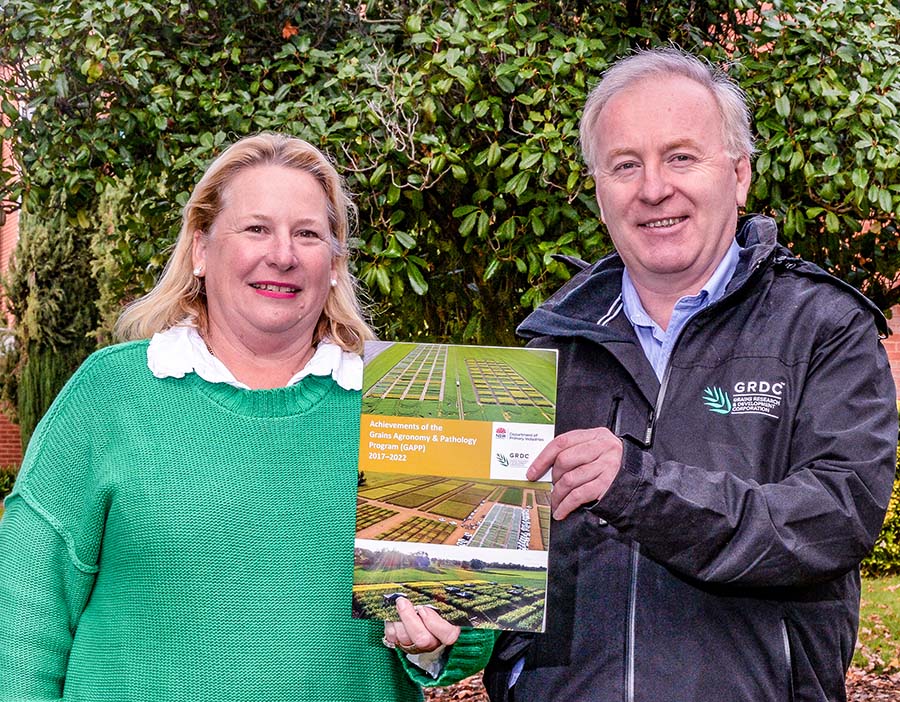An innovative, multi-million-dollar partnership that combined the might of Australia’s leading research investor, GRDC, with the internationally recognised and applied research capability of the New South Wales Department of Primary Industries (NSW DPI) to drive change for grain growers was celebrated in Wagga Wagga today (June 16).
Since the Grains Agronomy and Pathology Partnership (GAPP) was officially formed in 2017 to drive innovation and build capacity and capability for the Australian grains industry it has received a total of $64.6 million investment from GRDC and NSW DPI.
With the five-year partnership – in its current form – finishing on June 30, researchers, growers, agronomists and representatives from GRDC and NSW DPI gathered at the Wagga Wagga Agricultural Institute this week to acknowledge some key outcomes.
GRDC Managing Director Nigel Hart says the GAPP project was initially developed to focus on winter crop agronomy and pathology, as well as support capacity and infrastructure in grains research.
“The partnership has been focused on delivering on a range of projects that increased productivity and innovation, as well as the sectors’ capacity to respond to risk and improved grower profitability through better disease and pest management and reduced input costs,” Mr Hart says.
“Both parties, and importantly the grains sector, consider it a successful partnership, where our combined commitment to research collaboration reduced duplication, allowed targeted, strategic research, development and extension (RD&E) projects and ensured a focus on new technologies and infrastructure.
“Acknowledging the success of the partnership, showcasing the hard work and efforts of researchers and reviewing what has been delivered for growers and advisers is really important.”
Today’s GAPP event included a bus tour of trial sites at the DPI Wagga Wagga Agricultural Institute and presentations from the NSW DPI cropping team, as well as discussions with industry stakeholders exploring emerging issues and future opportunities.

GRDC and NSW DPI celebrated in Wagga Wagga today. Photo: Nicole Baxter
NSW DPI Director General Scott Hansen says the ongoing successful working relationship with GRDC is integral to growing stronger primary industries in NSW, with the state recording a 2020-21 cropping output of $8 billion.
“The innovation of our DPI researchers across 58 GAPP projects has meant growers in NSW are receiving the right advice to enable them to boost their business profitability through improved on-farm cropping practices,” Mr Hansen says.
Mr Hansen says the partnership between GRDC and DPI, as well as on-going collaboration with NSW growers, has delivered significant benefit to industry through either long-term savings or returns, according to cost benefit analysis conducted across a number of projects.
“Analysis indicates the GAPP’s research-based plant diagnostic service, which enables growers to identify and manage diseases early, has the potential to save the industry an estimated $20 million over the next 10 years,” Mr Hansen says.
“Similarly the GAPP’s phenology research to understand and determine optimal flowering periods by area, variety and sowing time could potentially return $23 million to growers if adopted.
“These are some examples of robust research that can assist growers and advisers to make decisions on-farm.”
Mr Hart says negotiations were also well advanced for the next phase of RD&E investment between the two organisations.
“GRDC values the close relationship we have with NSW DPI and are committed to co-partnering, co-investing and co-designing RD&E to help growers improve their long-term profitability and sustainability,” he says.
“Going forward our focus is on strategic partnerships with an emphasis on innovation through high impact investments that deliver positive return on investment but may have longer lead times and come with a higher risk.”
Mr Hart says to date current partnership discussions with NSW DPI had focused on two key areas for proposed new investments: national biosecurity and crop protection diagnostics and surveillance and a soils, agronomy and farming systems initiative.
“GRDC will also continue to make ongoing RD&E investments for NSW grain growers across a broad range of areas that improve understanding and on-farm decision making. These include disease surveillance and diagnostics, crown rot management, long coleoptile wheat and barley phenology,” he says.

























































